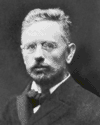
The Great Vowel Shift was a massive sound change
affecting the long vowels of English during
the fifteenth to eighteenth centuries. Basically, the long vowels shifted
upwards; that is, a vowel that used to be pronounced in one place in the
mouth would be pronounced in a different place, higher up in the mouth.
The Great Vowel Shift has had long-term implications for, among other things,
orthography, the teaching of reading, and the understanding of any English-language
text written before or during the Shift. Any standard history of the English
language textbook (see our sources) will
have a discussion of the GVS. This page gives just a quick overview; our
interactive See and Hear page adds sound and
animation to give you a better sense of how this all works.

"Discoverer" of the GVS Picture by courtesy of Det Kongelige Bibliotek, Copenhagen |
When we talk about the GVS, we usually talk about it happening in eight steps. It is very important to remember, however, that each step did not happen overnight. At any given time, people of different ages and from different regions would have different pronunciations of the same word. Older, more conservative speakers would retain one pronunciation while younger, more advanced speakers were moving to a new one; some people would be able to pronounce the same word two or more different ways. The same thing happens today, of course: I can pronounce the word "route" to rhyme with "boot" or with "out" and may switch from one pronunciation to another in the midst of a conversation. Please see our Dialogue: Conservative and Advanced section for an illustration of this phenomenon. |

What is this trapezoid? | What do these funny letters mean?
For another text-based introduction to the GVS, see the Great
Vowel Shift section of the Geoffrey
Chaucer Website.
Copyleft © Melinda J. Menzer 2000